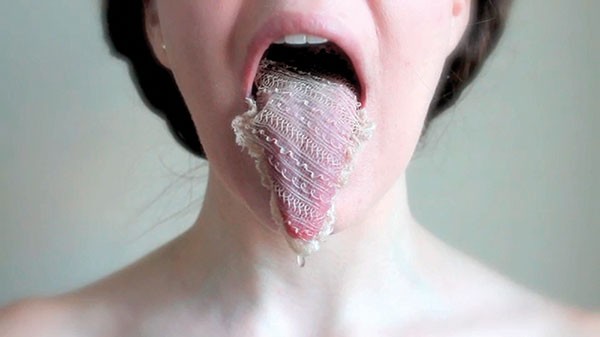Fiberart International 2016 defines its medium as anything “made of flexible, linear materials and/or constructed using textile techniques such as stitching, weaving, dying and embroidering.” The half of this venerable triennial that was housed at Pittsburgh Center for the Arts has closed, but the half at the Society for Contemporary Craft (comprising three dozen works) might go even further in its elastic understanding of that definition.
To be sure, some of the best work is pretty traditional. Rena Wood’s “Unravelled” is an abstract precisely hand-embroidered on silk, its sinuous forms in black, white and gray. In Dawn Williams Boyd’s “The Artist’s Muse,” a naked brown woman’s limbs are rudely grasped by three disembodied hands, each part of the crazy-quilted pattern around her. Elizabeth Mackie’s lovely “Ortler Kettles, #2” consists of three window-sized panels of off-white handmade paper, ceiling-hung one in front of the other, with leaflike shapes excised so as to dapple the work’s interior with light. And three boxy woolen men’s suits from the former Yugoslavia, screenprinted with battered, unpeopled urban buildings, comprise “In Memoriam,” Maja Gecic’s reminder of civil war.
But jurors Chunghie Lee, Arturo Alonzo Sandoval and Tali Wienberg also have a sharp eye for new kinds of “flexible, linear materials.” Peter Clouse’s “Redirect” is a wall-hanging of woven, mostly black electronic cords, USBs and RCAs alike, a postmodern quilt if there ever was one. Perhaps it’s a comment on consumer excess — something you could easily read into Steve Totin’s “Plasterra (White),” with its found plastic bottle-caps wired together, sprawling across the gallery floor like an amoeba. Indeed, the show has its share of social commentary, including Patricia Kennedy-Zafred’s photo-quilt commemorating the Nisei relocations and Dafna Rehavia’s mixed-media work “Cutting,” which wrenchingly references female genital mutilation.
Somewhere in between the traditional and the avant garde are Amber O’Hara’s “Intestine Necklace” and April Dauscha’s “Custody of the Tongue: Veiling.” The former, dark-humored, is a crocheted art scarf, draped on a stylish mannequin, a dozen or more false-toothed red mouths erupting from its folds. And the latter includes a brief video of a woman inserting her tongue into a fitted, white handmade-lace sheath, then keeping her tongue stuck out; the pink organ writhes with the effort and drips saliva. It’s discomfiting, in a good way.
At the Society for Contemporary Craft, Fiberart International pushes boundaries
The jurors have a sharp eye for new kinds of “flexible, linear materials”

April Dauscha’s “Custody of the Tongue: Veiling”

